
 |
|||
| Sponsors websites: | |||
Turf breeding warms upBy Todd Layt New breeds of cool season turf come every year, but up until recently, new varieties of warm season turf were introduced less frequently. Breeding warm season turf in Australia has come a long way since 1965 when the late Rod Riley bred the first Australian Couch grass called Greenlees Park Couch. As of Mid 2009 there are 19 active Plant Breeders Rights applications for Cynodon (Couch), 15 varieties of Stenotaphrum (Buffalo), 5 varieties of Zoysia, 2 Queensland Blue Couch's and 3 vegetative Kikuyu types with a majority of them being bred in Australia. Most will probably not make it in the commercial world of turf. For the turf type to make it turf farms need to decide to grow it, and a market must be created for the turf. Many of these varieties are successful often being sold for home and amenity turf. Others have been successful in the sports turf market. On top of all these new varieties are the old favourites, like Wintergreen and Greenlees Park Couch. In this 3 part article we will look at many of the favourite warm season breeds and where they are available, plus the new ones and what it takes to breed these new grasses. In part 3, we will look at the first all purpose Australian Native Turf. Part one looks closely at sports couches. As a breeder of 8 varieties of turf, with 4 having been recently commercialised in Australia and one more established variety namely Sapphire Buffalo doing very well in both Australia and the USA, (and hopefully more in the future) I hope to give insight into what it takes to breed a new turf variety and what testing is needed to find where each turf works. Naturally I think my varieties are wonderful, as would any breeder who has poured his heart and soul into their creation, but in the end it is the market place that decides. If a couch ends up being used in lots of sporting venues it has become successful, making breeders such as the Late Rod Riley, and Peter McMaugh very successful sports turf breeders. Many homes and amenity areas have been turfed with Sir Walter Buffalo, making Brent Redman very successful with his creation, as too have Sod Solutions with Palmetto. Now there is a whole new generation of breeders coming through of which I include myself in this group. For the first time here is a showcase of all these turf types, with this issue focusing on sporting Couch types. Couch Couch turf is becoming very competitive, with many new varieties now about to hit the market place. From a breeders perspective, I find Couch cultivars very different and when breeding I choose the categories I wanted to bred for. Let’s compare say Tiff Eagle, Santa Ana, Greenlees Park Couch and Wintergreen as a way of understanding the 4 different groups I used for breeding. First we have the Greens couches such as Tiff Eagle, which only have one use, which is for putting greens and bowling greens. They have a very short internode length, and a super dense mat. These thatch incredibly, and need specialised equipment to maintain them. Let’s call this a Putting green couch. Later we can list these categories and put each of the couches into them. Then we have the medium short internode grasses such as Santa Ana, that are sometimes well suited to climates such as Melbourne for normal use, but thatch way too much in places like Sydney and Brisbane unless they are mown short and regularly, such as high profile sporting venues. Let’s call these Specialist Sporting Couches. Then there are the mid range and longer internode groups such as Wintergreen that fit very well into most parts of Australia for many sporting facilities, as well as amenity areas, and for high profile sporting facilities. Let’s call these the all rounders. Finally there are the ones that do really well in the warmer areas, that are again all rounders, but go into dormancy quicker or grow too slow in cooler regions, and thus do not do so well in cooler areas such as Melbourne but absolutely love it in Sydney and Brisbane. Greenlees Park Couch is an example of these. Let’s call them warm all rounders. Just for the record, in breeding I wanted all rounders, as the market is bigger for these, and breed one all rounder and one warm all rounder. Not everyone will agree with my categories, but as a turf breeder this is what I used before deciding on breeding goals. In my research prior to breeding my 2 new couch varieties I put all the couch types into these 4 categories. I had a trial at my premises growing all the varieties except the putting green Couches. After talking to people I found that it is very hard to have a Couch that works best in all climates, but there are some that do well in most, and some that need warmth, this is why I added the warm all rounder category. Then there is the Couch market place. Some want very fast growing types that repair well from wear, yet still look good, some want density, and some want low cost for large development projects. That is why there is such a wide choice of Couch types. Putting and Bowling Green couches. Although some use longer internode grasses for bowling greens and sometimes even golf greens, those varieties have other uses so they do not fit into this category. This category is for short internode couches that are almost always used on greens. The internodes of these varieties are usually around 10mm. The quality of these grasses is now getting so good that it could be said to use Bent in a warmer climate is environmentally poor practice. Tiff 328 - A dark green grass with a fine blade. It was the first of the Tif series of greens Couches and has now been surpassed in quality by Tifdwarf and TifEagle, particularly when it comes to speed on the green. A few Queensland growers still grow this. TifDwarf – It was evaluated and released in 1966 in the United States. It was one of the early varieties that set the standard for golf and bowling greens as far as short internode couches are concerned. It is a fine bladed grass with a dark green colour. This is grown by only a few turf growers in Australia, mainly in Queensland. TifEagle - Released by internationally recognized USDA/ARS plant geneticist Dr. Wayne Hanna, TifEagle is the third generation of Couch varieties developed exclusively for golf greens at the Coastal Plains Experiment Station in Tifton GA. TifEagle is claimed to be an improvement over TifDwarf and extensive research seems to prove it has a better quality as a greens Couch, and is noticeably quicker than previously bred varieties. It is sold by Twin View Turf in Queensland. It has a shorter internode than TifDwarf. I will not do this for many varieties but here is an example of the amount of work that goes into breeding a variety. More work does not always mean a better grass. TifEagle is a fine-textured 2n=3x=27 chromosome mutant derived by irradiating Tifway II stolons. Dormant stolons, obtained from Glenn W. Burton, were treated with 7000 rads of Cobalt 60 radiation on January 12, 1988. Radiation treated stolons were planted in steam-sterilized soil in the greenhouse at Tifton, GA immediately after treatment. Forty-eight putative mutants were selected and individually propagated (45 survived). On July 11, 1988, each surviving mutant was planted in the centre of separate 1.8 x 2.6 m plots and allowed to spread to full coverage. Beginning in April, 1989 and continuing through the 1990 growing season, the plots were mowed at .250 inch 3 times per week. In July 1990, a dense fine textured off-type was identified in putative mutant #2. Stolons from this plant were vegetatively increased, tested as TW72 and later named TifEagle. TifEagle has been evaluated in four replicated experiments at Tifton, GA since 1991, in nine replicated experiments by scientists in GA, FL, TX, SC, AL and OK, beginning in 1994 and on 24 golf courses in GA, FL, AL, CA, NC, TX, TN, MS, SC and AZ beginning in 1995. Novotek - An ecotype adapted to tropical conditions, and bred by Tropical Lawns in Northern Queensland. MS-Supreme, P18 and Champion Dwarf have PBR status, but I could find no one growing these varieties in Australia. I must say when visiting the USA I liked the look of Champion Dwarf. I think the Queensland Department of Primary industries still has some of these available. It seems very popular in the USA, so I am surprised no one is doing it here. Specialist Sporting Couches. These are varieties that usually have internodes of between 20mm and 37mm that without good green keeping practices thatch badly, particularly in warmer climates like Perth, Sydney, Adelaide, and Brisbane. These types are generally better suited to higher maintenance sporting facilities and are poorly suited to hack ovals and general amenity areas that get spasmodic maintenance. These varieties, as expected, often do well in sports turf evaluations. When looking at evaluations like these, please keep in mind that the testing is for turf types for high maintenance facilities. Rarely do you see the plots not being mown for 2 weeks, or mown at higher height, which happens all the time in the real world on hack ovals and some golf courses, and most amenity areas. In the sporting turf trials, please remember also that often many of the all rounders do well. In the next issue we will look at the two categories of the all rounders. Windsor green – Bred by the well renowned turf scientist Peter McMaugh. This couch just fits into the specialist sporting couch section as its internode was right on the cut off. It could be argued this could fit into the all rounder category, but I think it belongs here. After talking to Queensland growers I think in the warmer areas it does need regular mowing at a low height to keep higher quality. It has been around for quite a while, having its Plant Breeders Rights granted in 1994. This turf seems to spread well by stolons, and less by rhizomes. It has a lower salt tolerance than most other couch types, but has good wear tolerance withstanding abrasion due to its high fibre content, but recovery can be slow at times. It has been used on many sporting facilities with mixed results, many loving it, with some not so happy. There is no Couch that works everywhere, so this is to be expected. Grand Prix – This is a new kid on the block, but seems to be quickly getting a following amongst high maintenance high profile sporting venues. ´Grand Prix´ resulted from a program of crossing and back crossing other C. dactylon varieties to ´Wintergreen´. Breeder: David Nickson, Victoria. It's internode in my trials seems to be quite a bit shorter than Windsor green, and Santa Ana. It is a very dense grass with high shoot density. Without regular green keeper maintenance, I found it thatches, but in high maintenance sporting facilities this is a benefit. Grand Prix achieves good coverage of bare ground due to its many branching stolons and strong rhizome development. It is a sparsely seeding variety, producing only a few short seed heads relative to other couch cultivars. Santa Ana – An old favourite of sporting venues in Melbourne. Here it is liked for its density and good winter activity. Many still claim this is the best grass for sporting venues in Melbourne. In the warmer climates it is generally disliked due to the high amount of thatch build up, although some higher maintenance sporting facilities still use it in Sydney. In Queensland its high thatch build up makes it a poor choice. In WA and SA it is a specialist grass, and like elsewhere it needs regular short mowing. Santa Ana was developed by the University of California in the 1970's. Winter Gem – This short internode Couch was selected for its winter quality and colour retention for Victoria. This has shorter internodes than most other varieties in this group. This grass will probably be better suited to a cooler climate and require very regular short mowing. It seems to mow well down to 6mm with a cylinder mower. This is a new release and was bred by David Nickson. Oz-E-Green – In my evaluations I found this grass to be a little different in that it seemed to stay shorter without mowing, and seemed to go longer without a trim. However, I still believe after a while thatch management needs to be addressed with this grass, particularly in warmer climates. It seems to scalp a little less than the others in this group when mown less frequently, but due to its very short internode, I still think it should be considered mainly as a grass for higher maintenance sporting facilities, although it may not grow fast enough to handle the wear. It will take longer than most in this group to build up thatch, but eventually it will. I think this grass could have good potential for certain sporting facilities in Queensland. It also has good salt tolerance. TifSport - Bred at Tifton by the University of Georgia and the USDA in a program led by Dr Wayne Hanna. This Couch has become a very popular choice for sporting facilities in the USA. As with most other grasses in this category TifSport is good for Sportsfields (including soccer, rugby union and rugby league fields), golf course fairways and green surrounds. It is unsuited to golf course roughs as TifSport does not perform well at higher mowing heights. This dense fine textured couch turf is tolerant of low mowing heights to 4 mm, and maintains good quality at 12 mm and 25 mm. It does not maintain good quality at greater mowing heights. TifSport was selected for superior cold tolerance (survives very cold temperatures) for regions that get colder than most parts of Australia, retaining colour in cooler nights, becoming light green near freezing. For regions like Melbourne TifSport has long winter dormancy, but responds quickly to warmer temperatures in spring. TifSport has excellent wear tolerance and recovers from wear well, but has poor salt tolerance. It is mainly grown in Queensland. Hatfield is another couch that may be best categorised into this group, but it is not easily available so there is not much reason to talk about it. Plateau could possibly fit here as well, but my experience with this grass says it needs to fit into the all rounder category. The grasses in the specialist sporting couch category do need regular short mowing, and as such make good selections for high maintenance sporting facilities. For venues like golf courses where the Couch needs to be used on fairways and roughs, personally I think the all rounders make a better choice unless they are used for fairways only and another grass is chosen for the roughs. To be used on roughs, a higher mowing height is needed, and these specialist short internode Couch types do not do well when mown taller. Theses shorter internode Couch types are also generally poor for over-sowing, where as medium to longer internode Couches lend them self to over-seeding with Rye. In the next issue we will look at the Couch All Rounders for both southern and northern regions of Australia, and blue Couch turf types for Queensland. |
|||||
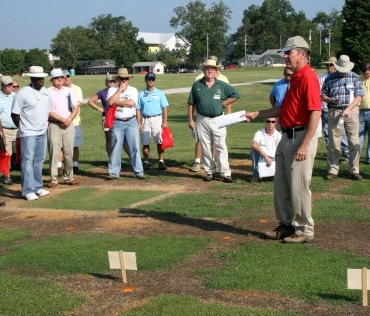 |
|||||
| University of Georgia turf breeder Wayne Hanna is shown giving a variety update during the 2008 UGA Turfgrass Field Day in Griffin, Ga. | |||||
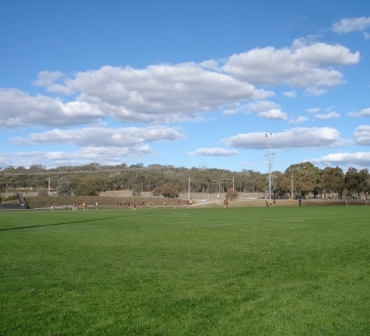 |
|||||
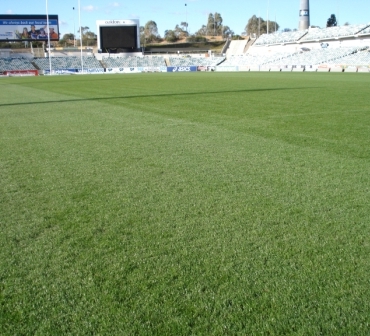 |
|||||
| Very dense sports Couch varieties are not good for oversowing. Longer internode Couch types work much better. We show case these in the next issue. | |||||
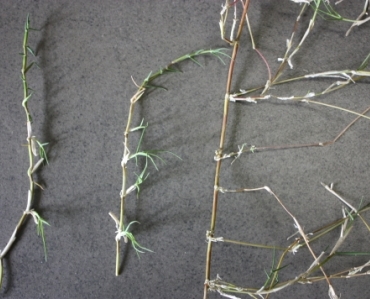 |
|||||
| All the Specialist Sports Couch types have a much shorter internode than Wintergreen. (On right) | |||||
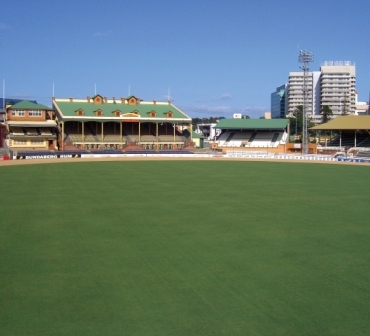 |
|||||
| Next issue we look at longer internode varieties for general sports Couches. | |||||